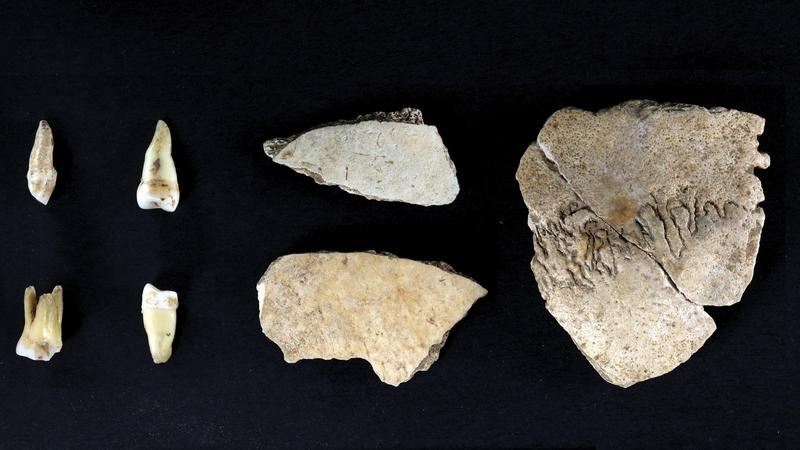List of top 10 discoveries comes from bumper year, with over a thousand excavations launched
 Jade rings from Xiaonanshan site in Raohe county, Heilongjiang province. (PHOTO PROVIDED TO CHINA DAILY)
Jade rings from Xiaonanshan site in Raohe county, Heilongjiang province. (PHOTO PROVIDED TO CHINA DAILY)
Experts hailed a number of milestones achieved by China’s archaeologists last year, as the nation’s Top 10 New Archaeological Discoveries of 2019 were unveiled on May 5.
In the list, there is an implication that the “Out of Africa” hypothesis — which postulates that all ancestors of modern humans came from Africa — may need to be re-examined.
At the Jiegedong Paleolithic cave site in Hanzhong, Shaanxi province, archaeologists found human remains and stone tools from 100,000 to 15,000 years ago, which were described as “world-class” by Chen Xingcan, head of the Chinese Academy of Social Sciences’ Institute of Archaeology.
“Human activities were basically continuous in the area, according to the recovered materials. The findings provide key clues for further studies into the origin of modern humans in East Asia,” Chen said.
The earliest known evidence of the usage of jade artifacts in China, which can be dated back around 9,000 years, was found at Xiaonanshan in Raohe county, Heilongjiang province, where over 100 jade artifacts and related processing tools were unearthed.
“That will reshape our understanding of Chinese jade,” Chen said.
 Human teeth and skull fragments from Jiegedong Paleolithic cave site in Hanzhong, Shaanxi province. (PHOTO PROVIDED TO CHINA DAILY)
Human teeth and skull fragments from Jiegedong Paleolithic cave site in Hanzhong, Shaanxi province. (PHOTO PROVIDED TO CHINA DAILY)
On the site by the China-Russia border, where ancient human settlement took place from 17,000 years ago to the Western Han Dynasty (206 BC-AD 24), there is also the earliest-known pottery in northern China, from about 14,000 years ago, he said.
Considering the rich jade tradition in China, Hanxia, another site on the list in Dunhuang, Gansu province, where jade quarrying flourished for almost two millennia until the Han Dynasty (206 BC-AD 220), will help archaeologists figure out where the raw materials for the exquisite artifacts originated.
A similar case is in Xiwubi, a site in Shanxi province that was home to a booming bronze industry.
“Bronze appeared earlier in western Asia,” said Wang Wei, president of the Chinese Society of Archaeology. “But as the technology came to China, a unique ceremonial system based on much more complicated bronze artifacts was gradually developed since about 4,500 years ago.
“The finding in Xiwubi may throw light on how the manufacturing of bronze artifacts contributed to the rise of powerful kings,” Wang said.
 Bronze sculpture from Zaoshulin nobles’ tomb site in Suizhou, Hubei province. (PHOTO PROVIDED TO CHINA DAILY)
Bronze sculpture from Zaoshulin nobles’ tomb site in Suizhou, Hubei province. (PHOTO PROVIDED TO CHINA DAILY)
Studies of ancient Chinese cities can make a big step forward thanks to the 4,000-plus-year-old Pingliangtai site in Henan province, where there is evidence of a drainage system, good urban planning and China’s oldest double-wheel rut — a depression or groove made into a road by wheels.
Speaking of early Chinese cities, Huangchengtai, part of the ruins of Shimao, in Shenmu, Shaanxi province, from over 4,000 years ago, may raise more questions than offer answers.
Shimao, which covers 4 million square meters, has in recent years continuously interested archaeologists, who have been trying to understand which specific civilization it belonged to. The discovery of a huge terrace last year, where magnificent walls and 70 stone-relief totems stood, has made scholars even more curious about the potential importance of this ancient city.
“The terrace may indicate a political or religious hub,” Wang said. “Other findings there had close connections with artifacts from later periods in China. It’s even difficult to estimate now what these discoveries mean for studies of the origins of Chinese civilization.”
 Clay eagle from Huangchengtai site in Shenmu, Shaanxi province. (PHOTO PROVIDED TO CHINA DAILY)
Clay eagle from Huangchengtai site in Shenmu, Shaanxi province. (PHOTO PROVIDED TO CHINA DAILY)
 Nanhai One, a shipwreck salvaged off the coast of Guangdong province. (PHOTO PROVIDED TO CHINA DAILY)
Nanhai One, a shipwreck salvaged off the coast of Guangdong province. (PHOTO PROVIDED TO CHINA DAILY)
From the ruins of a Han Dynasty city in the Xinjiang Uygur autonomous region to Nanhai One, a salvaged underwater shipwreck from the Tang Dynasty (618-907) off the coast of Guangdong province, other finds from various periods on the list highlight the Silk Road and its maritime counterpart, which contribute to the communication among different cultures.
It may have been a tough decision for judges to list the top 10 as 2019 was a bumper year for Chinese archaeology. Last year, 1,096 archaeological excavations were launched all over China, the most in history, said Song Xinchao, deputy director of the National Cultural Heritage Administration.
The annual list was compiled by the Beijing-based newspaper China Cultural Relics News.
 Earthenware uncovered from Xiwubi site in Jiangxian county, Shanxi province. (PHOTO PROVIDED TO CHINA DAILY)
Earthenware uncovered from Xiwubi site in Jiangxian county, Shanxi province. (PHOTO PROVIDED TO CHINA DAILY)
Due to the novel coronavirus outbreak, this year’s appraisal and the announcement of the top 10 were conducted online.
From May 1 to 5, daily livestreaming broadcasts of the final round of appraisal were made on the internet. Project leaders of the 20 finalists delivered presentations and had online Q&A sessions with the judging panel. According to official statistics, the five-day livestream attracted over 28 million views in total through multiple online platforms.


